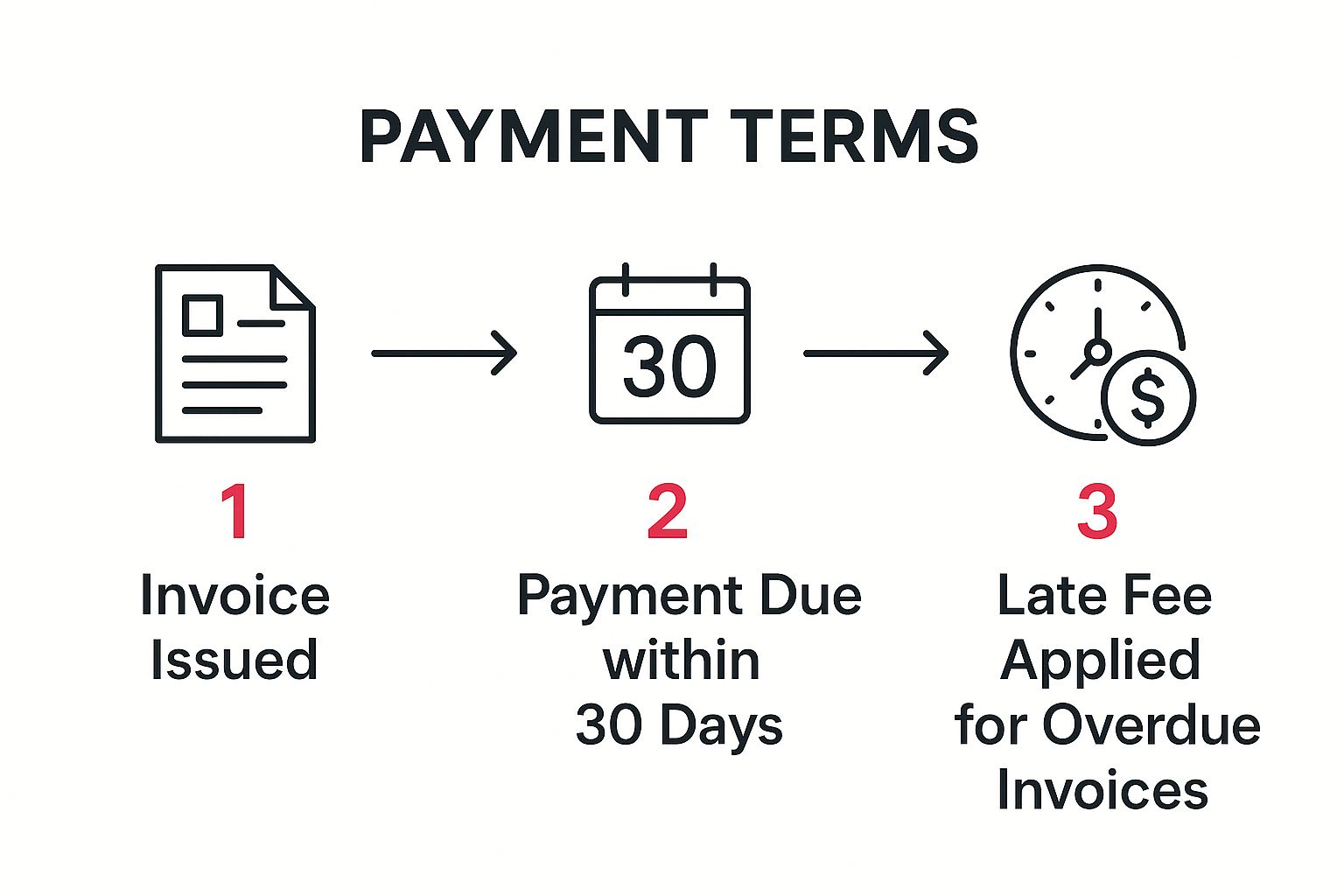 Finding Influencers for Your Brand: Proven Strategies to Succeed
Finding Influencers for Your Brand: Proven Strategies to Succeed
An influencer marketing contract is a legally binding agreement that spells out the terms, deliverables, and expectations between your brand and a creator. Think of it as the foundational blueprint for a successful campaign. It's what keeps everyone on the same page and ensures both you and the influencer are protected and aligned on the same goals.
Table of Contents
Why You Can't Afford to Skip Influencer Contracts

Let's be real for a second. Handshake deals and casual DM agreements for influencer campaigns are a recipe for disaster. As influencer marketing has evolved from a fun experiment into a core part of many marketing budgets, the stakes have gotten much, much higher. Flying without a contract is just asking for campaign chaos, wasted money, and even damage to your brand's reputation.
Imagine this scenario, which happens more often than you'd think: You ship $500 worth of product to a creator after a friendly exchange in their DMs. They promise a killer Reel and three Stories. Weeks pass. Crickets. When they finally post, it’s a low-quality, blurry photo with the wrong account tagged and none of your key messaging.
Without a contract, what can you do? Absolutely nothing. The product is gone, your budget is torched, and your brand just looks amateurish for being involved.
Protecting Your Investment and Reputation
A well-drafted influencer contract is so much more than a legal formality—it’s the strategic roadmap that protects your entire partnership. It turns vague promises into concrete, enforceable obligations, making sure every penny you spend is working towards a clear objective.
An influencer marketing contract prevents misunderstandings by clearly defining the scope of work, content rights, and payment schedules. It's the single most important document for protecting your brand's investment and reputation in any creator collaboration.
This protection isn't just a "nice to have" anymore. The industry is booming, with the global influencer marketing market projected to soar to $32.55 billion in 2025. On top of that, 26% of brands now dedicate over 40% of their marketing budget to these campaigns. When you're playing with that kind of money, locking down the details is non-negotiable.
A great contract doesn't need to be overly complicated, but it must cover the essentials to be effective. It’s about creating a clear, shared understanding of the partnership from day one.
Core Components of an Ironclad Influencer Contract
| Component | Why It's Critical |
|---|---|
| Clear Deliverables | Defines exactly what content will be created (e.g., 1 Reel, 3 Stories, 1 blog post), preventing scope creep. |
| Payment Terms | Outlines the compensation amount, payment method, and schedule (e.g., 50% upfront, 50% on completion). |
| Content Approval & Revisions | Specifies the review process, ensuring content aligns with brand guidelines before it goes live. |
| Usage Rights & Licensing | Clarifies how and where the brand can use the influencer's content, and for how long. |
| Exclusivity Clause | Prevents the influencer from working with direct competitors for a specific period. |
| FTC Disclosure Guidelines | Ensures the influencer agrees to legally required disclosures (e.g., #ad, #sponsored), protecting your brand from legal trouble. |
| Termination Clause | Lays out the conditions under which either party can end the agreement, protecting you from non-performance. |
Having these elements in place transforms a casual arrangement into a professional partnership built on mutual respect and clarity.
Setting the Stage for a Successful Partnership
Ultimately, presenting a contract signals that you're serious about the collaboration and that you value the creator's time and talent. It builds a foundation of trust right from the start.
By getting all the nitty-gritty details sorted out upfront, you free up both your team and the creator to focus on what really matters: creating incredible, authentic content that truly connects with your target audience. To see how these collaborations fit into the bigger picture, this comprehensive guide to digital marketing offers fantastic context.
Breaking Down the Must-Have Contract Clauses
Diving into an influencer marketing contract can feel like navigating a legal minefield, but it doesn't have to be. Think of these clauses less as hurdles and more as the foundation for a clear, successful partnership. When a contract is well-defined, it cuts out all the guesswork, making sure both you and the creator are perfectly aligned on what’s expected.
Let's move past a simple checklist and really get into the nitty-gritty of what makes an influencer agreement solid. Once you understand the "why" behind each clause, you'll be in a much better position to protect your brand, manage expectations, and set your campaign up for success right from the start.
Scope of Work and Deliverables
This is, without a doubt, the most important part of your entire influencer agreement. I've seen more campaigns go sideways because of a vague scope than for any other reason. Just writing "one promotional post" is a recipe for disaster and leaves way too much open to interpretation.
You have to get hyper-specific about what the creator will actually produce. For instance, instead of being general, your deliverables should look something like this:
- Content Format: One 60-second Instagram Reel plus three consecutive Instagram Stories that include a link sticker.
- Key Messaging: The content must highlight our "eco-friendly packaging" and mention the "limited-time 20% discount code."
- Posting Schedule: The Reel needs to go live on Tuesday, October 26th, between 9 AM and 11 AM EST.
- Tags and Hashtags: The post must tag @YourBrand and include the hashtags #YourBrandPartner and #CampaignHashtag.
This level of detail means the influencer knows exactly what success looks like, and you're guaranteed to get the specific promotion you paid for.
Compensation and Payment Terms
Nothing sours a professional relationship faster than confusion over money. This clause needs to leave zero doubt about how, when, and how much the influencer will be paid. State the total compensation clearly, whether it’s a flat fee, a commission deal, or some hybrid of the two.
Beyond the total amount, your payment terms need to be spelled out. A common and fair approach is to pay 50% of the fee when the contract is signed and the final 50% after all the deliverables are completed. This builds good faith and gives the creator a real incentive to finish on time. You also need to detail the payment method (like a bank transfer or PayPal) and the net payment terms (e.g., Net 30, which means you'll pay the invoice within 30 days).
The graphic below outlines a standard payment process that keeps everything running smoothly.

Following a simple, predictable flow like this is critical for building trust and a good reputation among creators.
Content Usage Rights and Exclusivity
This is a big one, and it’s where a lot of brands stumble. Just because you paid an influencer to create content doesn't automatically mean you own it or can use it wherever you want. The creator almost always retains the copyright; what you're getting is a license to use their content.
Key Insight: Without clearly defined usage rights, you could find yourself in legal hot water for using the influencer's content in paid ads, on your website, or in email campaigns. You must explicitly state how, where, and for how long you can use their work.
For example, your contract might say something like: "Brand is granted a non-exclusive license to repurpose the content on its organic social media channels (Instagram, TikTok) and in paid digital ads for one year from the initial post date."
The exclusivity clause is just as important. It prevents the influencer from partnering with your direct competitors for a specific period, protecting your investment and making sure your message isn’t diluted. Just be reasonable with the timing. A typical exclusivity window might run from the day the contract is signed until 30 days after the campaign ends. To make sure you've covered all your bases, using a comprehensive contract review checklist can be a real lifesaver in spotting any gaps.
Getting Specific: How to Define Campaign Deliverables That Actually Work

Here's where a lot of influencer campaigns fall apart: vagueness. A contract that just says "one Instagram post" is practically asking for trouble. Ambiguity leads to content that doesn't align with your goals, and ultimately, a wasted budget.
For a campaign to have any chance of success, you have to translate your high-level marketing goals into very specific, tangible deliverables in the contract. This is about more than just counting posts. It’s about mapping every single detail back to performance.
Let's say your goal is driving website traffic. If you don't explicitly state in the contract that the influencer must use a specific UTM-tracked link in their bio and include a clear call-to-action, you're leaving it to chance. Good luck proving their ROI without that.
Detailing the Exact Content You Expect
Don't assume an influencer knows what you're thinking. To avoid any confusion, your contract needs to spell out exactly what they will create and post.
A solid list of deliverables should cover things like:
- Content Format Specifics: Instead of asking for "social media content," get granular. Specify "one 45-60 second Instagram Reel" or "three consecutive Instagram Stories, each with a link sticker." Different formats achieve different things, so be precise.
- Mandatory Tags and Hashtags: This is non-negotiable. The contract must require the influencer to tag your official brand handle (like @YourBrand) and use specific campaign hashtags (like #BrandCampaign2024). It's crucial for tracking and unifying the campaign.
- Call-to-Action (CTA) Language: Give them the exact words to use. Something like, "Shop the new collection via the link in my bio!" or "Use my code PARTNER20 for 20% off your first order."
This isn't micromanaging; it's setting the partnership up for success. When the influencer knows exactly what's expected, they can produce content that's on-brand and optimized to hit your targets.
Key Takeaway: The best influencer contracts eliminate guesswork. When you detail everything from the content format down to the exact CTA, you and the influencer share the same definition of success. It also gives you a concrete way to measure if the campaign actually worked.
Establishing a Clear Approval and Revision Process
Your brand has a certain look, feel, and voice. The influencer's content has to match. A formal approval process written into the contract is your best line of defense for quality control.
This clause should clearly state that all content must be submitted for your review at least 48-72 hours before it’s scheduled to go live. This simple step protects everyone. You get to catch any messaging that's off-brand, incorrect product info, or a missed requirement. The influencer is protected from posting something that you later dislike, which could sour the relationship.
This is becoming even more critical as the industry shifts. With 47% of marketers now focusing on longer-term influencer partnerships, these contracts aren't just for one-off campaigns anymore. They are essential business agreements that integrate creators into your core marketing strategy. If you want to dig deeper, you can discover more stats about key marketing trends that highlight this shift.
Finally, your contract should specify how many rounds of revisions are included in the fee—usually one or two is standard. This prevents endless edits and keeps the campaign moving forward.
Navigating FTC Rules and Legal Requirements
Let's talk about the less glamorous but absolutely critical side of influencer marketing: staying out of legal hot water. The rules set by the Federal Trade Commission (FTC) aren't suggestions—they're strict requirements. Your contract is your primary tool for making sure everyone involved plays by those rules.
At its core, FTC compliance boils down to one word: transparency. If an influencer has a "material connection" to your brand—meaning you've paid them, sent them free products, or provided any other compensation—they must disclose that relationship clearly. It’s not just good practice, it’s the law, and you need to make this an explicit, non-negotiable part of your agreement.
Mandating Clear FTC Disclosures
The days of burying a vague #collab in a mountain of other hashtags are long gone. The FTC demands that disclosures are impossible to miss. A tiny #sp just won't fly.
Your contract needs to spell out exactly what's required. Don’t leave any room for interpretation.
- Specify the Hashtags: Insist on clear, unambiguous hashtags like #ad or #sponsored. I recommend making one of these the very first part of the caption.
- Dictate the Placement: The disclosure has to be "above the fold." For an Instagram post, this means it's visible before a user has to tap "…more" to expand the caption.
- Cover All Formats: For video content on TikTok, Reels, or YouTube, the disclosure needs to be both in the video itself (spoken or with on-screen text) and in the description box.
By making FTC compliance a non-negotiable clause in your influencer marketing contract, you shift the responsibility to the creator while demonstrating your brand's commitment to ethical advertising practices. This protects you from potential fines and reputational damage.
Securing Intellectual Property and Originality
Beyond disclosures, your contract is your shield against intellectual property (IP) headaches. You're paying for content, and you need a rock-solid guarantee that it's 100% original and doesn't step on anyone else's copyright.
Picture this: your influencer creates an amazing Reel for your campaign but uses a trending song they don't have the commercial license for. The song's publisher could hit both of you with a takedown notice or, worse, a lawsuit.
This is where an indemnification clause becomes your best friend. This clause is a formal declaration from the influencer that their work is entirely their own. It also states that they will cover any legal costs if a claim arises from them using unlicensed music, photos, or video clips. It’s a crucial piece of legal protection for your business.
The Importance of Confidentiality and Termination
Not everything about your campaign should be public knowledge. A confidentiality clause is standard practice and prevents influencers from leaking sensitive details like your campaign budget, launch dates for unannounced products, or internal strategy documents. This is key to keeping your competitive advantage.
Finally, you need an escape hatch for when things go south. A termination clause is your safety net. It clearly defines the circumstances under which either party can walk away from the agreement. This could be triggered by anything from consistently missed deadlines and low-quality work to a major breach of contract, like failing to add the required FTC disclosures. This clause provides a clean, legal exit from a partnership that’s become a liability.
Negotiation Tips and Red Flags to Watch For

Think of the negotiation phase as the first real date with a potential influencer partner. The back-and-forth isn't a battle; it's a conversation that sets the tone for the entire relationship. How these discussions unfold is often a crystal-clear preview of how your campaign will actually play out.
The goal is to collaboratively build an influencer marketing contract that works for both of you. When money comes up, don't just react to their initial asking price. Come to the table armed with research on what's standard for their niche, follower count, and engagement rates. Be ready to talk about the total value you bring, which often goes beyond just the cash payment. This could be high-value products, unique experiences, or exposure to your brand's audience.
But successful negotiation isn't just about haggling over rates. It's about being observant. You need to keep an eye out for red flags—the subtle (and not-so-subtle) signs that a partnership might be more trouble than it's worth. Spotting these early can save you a world of headaches down the line.
Critical Red Flags You Can't Ignore
Pay close attention to how the influencer—or their representation—handles the negotiation process. If a creator is disorganized, unprofessional, or difficult before any ink is dry, you can bet that behavior will only get worse once the campaign is underway. On the flip side, when creators work with experienced influencer agents, the process is often much smoother, as they know how to navigate terms professionally.
Here are a few major warning signs to watch for:
- Resistance to a Formal Contract: This is the biggest dealbreaker. If an influencer wants to work on a "handshake deal" or verbal agreement, walk away. It's a massive risk and a clear sign they aren't a serious professional.
- Arguing About FTC Disclosures: Any pushback on including
#ad,#sponsored, or other required disclosures is a problem. It signals a disregard for legal and ethical standards, which could put your brand in hot water. - Poor Communication: Is the influencer slow to respond? Do they dodge direct questions? Vague or evasive answers during negotiation usually translate to missed deadlines and poor communication during the campaign itself.
- Unreasonable or Lopsided Demands: Be cautious of influencers demanding things like total ownership of the content forever or asking for a fee that's wildly out of line with their actual performance metrics.
A negotiation isn’t just about the terms; it’s a preview of your working relationship. An influencer who is collaborative, professional, and transparent during contract talks is more likely to deliver great results.
As the industry evolves, so do the agreements. With 73% of marketers believing that influencer marketing workflows could be largely automated, contracts must now be even more detailed. They need to account for everything from new performance metrics to compliance with emerging technologies. You can read the full report on influencer marketing trends to get a better sense of where things are headed.
Got More Questions? Here Are Some Quick Answers
Even with the best template in hand, you're bound to run into some unique situations. I get these questions all the time from brands, so let's tackle some of the most common head-scratchers when it comes to influencer contracts.
Think of this as your go-to cheat sheet for handling those tricky details.
Do I Really Need a Contract for a Gifted Collaboration?
Yes, you absolutely do. I can't stress this enough. Sending out free products without an agreement is just a hope and a prayer—and often, it ends in you getting ghosted. You send your product, and then… crickets.
A simple gifted collaboration agreement turns that hope into a professional deal. It clarifies exactly what you expect for your product, like one Instagram Story and one feed post. It also locks in a posting deadline and, just as importantly, makes it a legal requirement for them to disclose the gift according to FTC rules. It’s a non-negotiable for protecting your investment.
What's the Difference Between Ownership and Usage Rights?
This is easily the biggest point of confusion, and getting it wrong can be a costly mistake.
Here’s the breakdown:
- Content Ownership: This is about who holds the copyright. The creator almost always owns the photos and videos they produce. It's their intellectual property.
- Usage Rights: This is what you're actually paying for. It’s a license that gives your brand permission to use that content.
Your contract needs to spell out the usage rights in plain English. For instance, you might ask for "the right to repurpose content in paid social ads and on our website for one year." If you don't define these rights, you technically have no legal permission to use their content anywhere beyond their initial post.
My Two Cents: Don't think of it as buying the content. You're renting it. Be incredibly specific about how, where, and for how long you can use it to avoid legal trouble down the road.
How Long Should an Exclusivity Clause Last?
There's no single right answer here—it all comes down to what's reasonable and fair for the specific campaign. For a one-off project, a typical exclusivity period might start when the contract is signed and last until 30 days after the campaign ends. This simply ensures the influencer isn’t promoting your direct competitor the very next day.
If you're signing a long-term brand ambassador, the clause might last for the entire partnership. Just be careful not to overreach. Asking for a year of exclusivity for a single-post campaign is a surefire way to get major pushback or a demand for a much, much bigger paycheck.
Juggling all these details for every single creator can feel like a full-time job in itself. Getting the contract locked down is the crucial first step. When you're ready to scale up and manage multiple collaborations without the chaos, a platform like JoinBrands can be a lifesaver. It helps you find influencers, run campaigns, and see what's working, all in one place. You can connect with over 250,000 creators and make the whole process a lot smoother.








